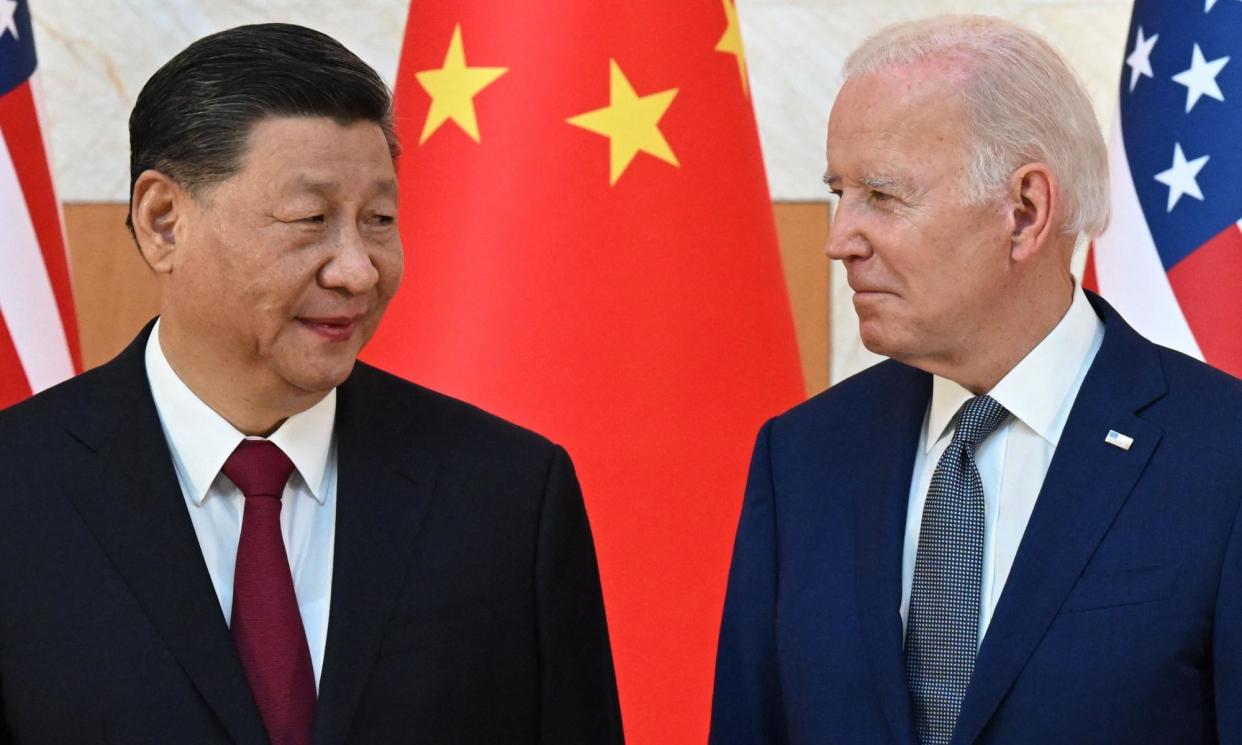Biden approves nuclear strategy refocusing on China threat – report

Joe Biden has approved a US nuclear strategy to prepare for possible coordinated nuclear confrontations with Russia, China and North Korea, according to a New York Times report on Tuesday.
On Tuesday, the White House said the president approved the plan earlier this year and it was not a response to a single country or threat.
The spokesperson Sean Savett said that while “the specific text of the guidance is classified, its existence is in no way secret. The guidance issued earlier this year is not a response to any single entity, country, nor threat.”
The Times reported that the deterrent policy takes into account a rapid buildup of China’s nuclear arsenal, which will rival the size and diversity of the US and Russian stockpiles over the next decade. The Russian president, Vladimir Putin, has threatened to use nuclear weapons in Ukraine.
According to research by the Stockholm International Peace Research Institute, China had an estimated 500 nuclear warheads in January, up from 410 in January 2023. The US and Russia have more than 5,000 warheads each. But China’s arsenal is thought to be expanding at a much faster pace than any other country’s.
The US-based Arms Control Association said it understood US nuclear weapons strategy and posture remained the same as described in the administration’s 2022 nuclear posture review, and there had been no reorientation away from Russia and toward China.
Daryl Kimball, the executive director of the Arms Control Association, said that while US intelligence estimates suggested China might increase the size of its nuclear arsenal from 500 to 1,000 warheads by 2030, Russia currently had about 4,000 nuclear warheads “and it remains the major driver behind US nuclear strategy”.
Biden approved the revised strategy – called the nuclear employment guidance – in March, according to the Times, but an unclassified notification of the policy change has not yet been presented to Congress.
After years of nuclear arms reduction efforts, the administration has been signalling willingness to expand the US arsenal to counter China and Russia’s nuclear strategies more recently. In February, the US warned allies that Russia could be planning to put a nuclear weapon into space.
On Tuesday, a retired senior colonel in the Chinese People’s Liberation Army, Zhou Bo, published a piece in Foreign Policy arguing that the US and China could still cooperate on nuclear diplomacy. Zhou said that “it is impossible for Beijing to stand by idly” in the face of deteriorating relations between Russia and the US, but that there was space to strengthen the policies governing the control of nuclear weapons stockpiles.
Zhou argued that nuclear-armed states should declare a “no first use” policy, as so far only China and India have done.
Related: Global spending on nuclear weapons up 13% in record rise
On Tuesday, the Times reported that two senior administration officials had earlier been permitted to allude to the revision in US nuclear strategy without disclosing its existence.
In June, Pranay Vaddi, a senior director of the national security council, warned that “absent a change” in nuclear strategy by China and Russia, the US was prepared to shift from modernisation of existing weapons to expanding its arsenal.
Vaddi also alluded to the highly classified document, saying it emphasised “the need to deter Russia, the PRC [People’s Republic of China] and North Korea simultaneously”.
The last major nuclear arms control agreement with Russia, New Start, which sets limits on intercontinental-range nuclear weapons, expires in early 2026 with no subsequent agreement in place.
China and Russia are now more politically and economically aligned. Last month, Chinese and Russian long-range bombers patrolled together near Alaska for the first time and held live-fire exercises in the South China Sea.
The second US administration official permitted to refer to the document, Vipin Narang, an MIT nuclear strategist who served in the Pentagon, said earlier this month that Biden had “issued updated nuclear weapons employment guidance to account for multiple nuclear-armed adversaries” and for “the significant increase in the size and diversity” of China’s nuclear arsenal.
“It is our responsibility to see the world as it is, not as we hoped or wished it would be,” the Times quoted Narang as saying. “It is possible that we will one day look back and see the quarter-century after the cold war as nuclear intermission.”


